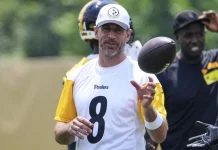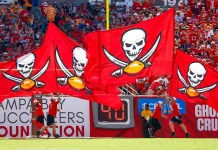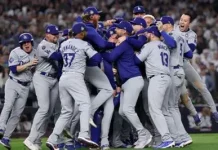GULLANE, Scotland (AP) — So much consternation about the fracture in the professional world of golf. So much speculation about where it will all lead.
That wasn’t just Tuesday at a Senate hearing on how the about-face agreement between the PGA Tour and the Saudis came together. That was last year during a British fortnight of golf, when what passed as scandal now seems rather small.
Consider the Scottish Open a year ago.
All the rage was Ian Poulter among three players who had defected to LIV Golf, won a preliminary injunction in a U.K. court and were allowed to play The Renaissance Club alongside European tour and PGA Tour players who felt he was double dipping.
Names were being whispered about who was next to join the rival league. A whisper became a question to Cameron Smith, whose Aussie chill vibe gave way to irritation when he was asked if he was joining LIV as he sat next to the silver claret jug he had just won.
PGA Tour Commissioner Jay Monahan, two years into this battle against the group with whom he now wants to partner, was described by more than one observer as looking like a U.S. president in his second term.
Greg Norman was mocked for his slogan of golf being a “force for good” and still being bullish on bringing free agency to golf, even though the LIV Golf schedule was more restrictive than anything the PGA Tour and European tour required.
What did it all mean? Where will it all lead?
At least the questions haven’t changed.
ADVERTISEMENT
Across the ocean on Tuesday, eight players were on the range at The Renaissance Club while a half-dozen others went through their drills on the putting range. Others were on the course for a late afternoon practice round, none seemingly interested in the Senate subcommittee hearing.
None had a say in the first place as the last five weeks has shown.
Smith won the LIV Golf-London event last week and said about going to Hoylake for his title defense in the British Open, “It feels like forever.”
Consider all that has transpired in the last year.
Poulter and others under the U.K. sports resolution ruling kept playing European tour events from London to the Middle East for the next eight months until the final ruling went against them, a decision handed down the week of the Masters.
Eleven players filed an antitrust lawsuit against the PGA Tour, and four of them tried to play in the FedEx Cup playoffs until a California judge refused to grant a temporary restraining order.
ADVERTISEMENT
LIV Golf joined the lawsuit, a countersuit was filed and the PGA Tour legal fees topped more than the $36 million Dustin Johnson won last year in LIV.
And what was described as a watershed moment in PGA Tour history now seems more like water under the bridge. Tiger Woods flew to Delaware to join Rory McIlroy and a small, elite group of players with the intent of reshaping the PGA Tour.
Monahan introduced a new model for the PGA Tour that created $20 million tournaments and a plan for the best to compete against each other upward of 17 times a year. That was described as a “bridge year,” though the concept for 2024 was the same with some wrinkles.
And to think the biggest argument was whether these $20 million tournaments with limited fields would have a cut (a topic that remains under discussion).
What to make of that Delaware meeting now? A blueprint for the future or a waste of time?
And where does golf go from here?
ADVERTISEMENT
Still to come is whether the PGA Tour policy board approves whatever final deal gets hammered out by the end of the year, if that even happens. According to the framework agreement, the sides have to get the deal done by Dec. 31 unless they agree to extend it.
Documents obtained ahead of the Senate subcommittee hearing painted a bleak future for Norman if the deal goes through. He has been less visible in recent weeks as CEO and commissioner of LIV Golf.
An early draft of a side agreement suggested his job would be eliminated when the PGA Tour took over management of LIV. That side agreement was never drafted, though Ron Price, the chief operating officer of the PGA Tour, said at the hearing the tour “would no longer have a requirement” for Norman’s role if the deal is ever finalized.
Meanwhile, golf still provides a break from all this drama. Whether LIV Golf players win a major (they have won two of the last four) or even contend no longer seems to spark the interest it once did.
Robert MacIntyre of Scotland was asked about the LIV controversy a year ago with the Scottish Open and British Open in front of him. “I have a chance the next few weeks to do something special and I’m not worry about what’s going on,” he said.
A year later, not much had changed.
“I don’t really read about it and I don’t see the ins and outs of what can happen,” he said Tuesday. “But for now, it’s just let the guys at the top of the table deal with it and I’ll get told what I need to know.






